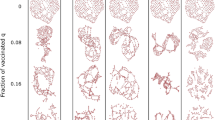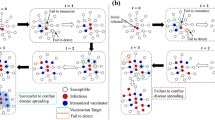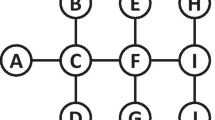Abstract
Vaccination is a vital strategy to prevent and control the spread of infectious diseases. In this paper, we propose a vaccination strategy that starts with community detection in a dynamic epidemic network, then uses centrality measures to identify spreaders in these communities, who are then targeted for vaccination. By vaccinating the most influential individuals in each community, we aim to achieve a highly vaccinated network that can effectively contain the spread of the disease. To test the effectiveness of the methods, we evaluate them using different evaluation metrics. Our strategy is also highly scalable and adaptable to different epidemic scenarios, making it a promising approach for future epidemic control.







Similar content being viewed by others
References
Aynaud T, Guillaume J-L (2010) Static community detection algorithms for evolving networks. In: 8th international symposium on modeling and optimization in mobile, Ad Hoc, and Wireless Networks. IEEE, Avignon, pp 513–519
Aynaud T, Guillaume J-L (2011) Multi-step community detection and hierarchical time segmentation in evolving networks. In: Fifth SNA-KDD workshop social network mining and analysis, in conjunction with the 17th ACM SIGKDD international conference on knowledge discovery and data mining. SNA- KDD, San Jose
Aynaud T, Fleury E, Guillaume J-L, Wang Q (2013) Communities in evolving networks: definitions, detection, and analysis techniques. In: Dynamics on and of complex networks. Applications to time-varying dynamical systems, vol 2. Springer, New York, pp 159–200
Bansal S, Bhowmick S, Paymal P (2011) Fast community detection for dynamic complex networks. Complex networks. Springer, Berlin, pp 196–207
Beauchamp MA (1965) An improved index of centrality. Behav Sci 10:161–163
Brin S, Page L (1998) The anatomy of a large-scale hypertextual web search engine. Comput Netw ISDN Syst 30(1):107–117 (Proceedings of the Seventh International World Wide Web Conference)
Clauset A, Newman ME, Moore C (2004) Finding community structure in very large networks. Phys Rev E 70:066111
Chen Z, Wilson KA, ** Y, Hendrix W, Samatova NF (2010) Detecting and tracking community dynamics in evolutionary networks. In: 2010 IEEE International conference on data mining workshops. IEEE, Sydney, pp 318–327
Dhouioui Z, Akaichi J (2014) Tracking dynamic community evolution in social networks. In: 2014 IEEE/ACM international conference on advances in social networks analysis and mining (ASONAM 2014). IEEE, Bei**g, pp 764–770
Duan D, Li Y, ** Y, Lu Z (2009) Community mining on dynamic weighted directed graphs. In: The 1st international workshop on complex networks meet information and knowledge management. ACM, New York, pp 11–18
Falkowski T, Bartelheimer J, Spiliopoulou M (2006) Mining and visualizing the evolution of subgroups in social networks. In: 2006 IEEE/WIC/ACM international conference on web intelligence (WI 2006 main conference proceedings) (WI’06). IEEE, Hong Kong, pp 52–58
Fortunato S (2010) Community detection in graphs. Phys Rep 486(3):75–174. https://doi.org/10.1016/j.physrep.2009.11.002
Fortunato S, Castellano C (2012) Community structure in graphs. Computational complexity theory, techniques, and applications. Springer, New York, pp 490–512
Freeman LC (1978) Centrality in social networks conceptual clarification. Soc Netw 1(3):215–239. https://doi.org/10.1016/0378-8733(78)90021-7
Gauvin L, Panisson A, Cattuto C (2014) Detecting the community structure and activity patterns of temporal networks: a non-negative tensor factorization approach. PLOS ONE 9:e86028
Goldberg M, Magdon-Ismail M, Nambirajan S, Thompson J (2011) Tracking and predicting evolution of social communities. In: 2011 IEEE Third international conference on privacy, security, risk and trust and 2011 IEEE third international conference on social computing. IEEE, Boston, pp 780–783
Gong M-G, Zhang L-J, Ma J-J, Jiao L-C (2012) Community detection in dynamic social networks based on multiobjective immune algorithm. Springer, Berlin, pp 455–467
Greene D, Doyle D, Cunningham P (2010) Tracking the evolution of communities in dynamic social networks. In: 2010 International conference on advances in social networks analysis and mining. IEEE, Denmark, pp 176–183
Guo C, Wang J, Zhang Z (2014) Evolutionary community structure discovery in dynamic weighted networks. Phys Stat Mech Appl 413:565–576
Görke R, Maillard P, Schumm A, Staudt C, Wagner D (2013) Dynamic graph clustering combining modularity and smoothness. J Exp Algorithmics (JEA) 18:1–1129
Herlau T, Mørup M, Schmidt MN (2013) Modeling temporal evolution and multiscale structure in networks. In: Proceedings of the 30th international conference on international conference on machine learning, vol 28, pp 960–968
Himmel A-S, Molter H, Niedermeier R, Sorge M (2016) Enumerating maximal cliques in temporal graphs. In: 2016 IEEE/ACM International conference on advances in social networks analysis and mining (ASONAM), pp 337–344
İlhan N, Öğüdücü G (2015) Predicting community evolution based on time series modeling. In: 2015 IEEE/ACM international conference on advances in social networks analysis and mining (ASONAM). IEEE, Paris pp 1509–1516
Matias C, Miele V (2015) Statistical clustering of temporal networks through a dynamic stochastic block model. J R Stat Soc Ser B Stat Methodol 79:1119–41
McDaid AF, Greene D, Hurley N (2011) Normalized Mutual Information to evaluate overlap** community finding algorithms. CoRR.
Nieminen J (1974) On the centrality in a graph. Scand J Psychol 15(4):332–336
Palla G, Barabasi A-L, Vicsek T (2007) Quantifying social group evolution. Nature 446:664–7
Rossetti G, Pappalardo L, Pedreschi D, Giannotti F (2016) An online algorithm for community discovery in dynamic social networks. Springer, Berlin, pp 1213–1241
Shannon CE (1948) A mathematical theory of communication. Bell Syst Tech J 27:379–423
SocioPatterns: SocioPatterns Dataset (2012). https://www.sociopatterns.org/datasets/high-school-dynamic-contact-networks/
Sun Z, Sheng J, Wang B, Ullah A, Khawaja F (2020) Identifying communities in dynamic networks using information dynamics. Entropy 22:425
Tnetwork Package. https://tnetwork.readthedocs.io/
Viard T, Latapy M, Magnien C (2016) Computing maximal cliques in link streams. Theor Comput Sci 609:245–252
Wang Y, Wu B, Pei X (2008) Advanced data mining and applications. Springer, Wuhan
Xu H, Wang Z, **ao W (2013) Analyzing community core evolution in mobile social networks. In: 2013 international conference on social computing. IEEE, Alexandria, pp 154–161
Zakrzewska A, Bader DA (2015) A dynamic algorithm for local community detection in graphs. In: 2015 IEEE/ACM international conference on advances in social networks analysis and mining (ASONAM). IEEE, Paris, pp 559–564
Acknowledgements
This research is carried out as a part of the project “Plateforme logicielle d’intégration de stratégies d’immunisation contre la pandémie COVID-19” funded by the grant of the Hassan II Academy of Sciences and Technology of Morocco.
Author information
Authors and Affiliations
Contributions
All authors participated equally in conducting analyses, drafting sections of the manuscript, editing, and approving the final submitted version.
Corresponding authors
Ethics declarations
Conflict of interest
The authors declare no competing interests.
Additional information
Publisher's Note
Springer Nature remains neutral with regard to jurisdictional claims in published maps and institutional affiliations.
Rights and permissions
Springer Nature or its licensor (e.g. a society or other partner) holds exclusive rights to this article under a publishing agreement with the author(s) or other rightsholder(s); author self-archiving of the accepted manuscript version of this article is solely governed by the terms of such publishing agreement and applicable law.
About this article
Cite this article
Laasri, N., Lotfi, D. & El Maliani, A.D. A targeted vaccination strategy based on dynamic community detection for epidemic networks. Soc. Netw. Anal. Min. 14, 126 (2024). https://doi.org/10.1007/s13278-024-01292-z
Received:
Revised:
Accepted:
Published:
DOI: https://doi.org/10.1007/s13278-024-01292-z




